AudioCulture
The noisy library of New Zealand music
Te pātaka korihi o ngā puoro o Aotearoa
Crude
aka Matt Middleton
Initially enlisted by benevolent Christians to learn the recorder, Invercargill-born Middleton advanced to clarinet in the Southland Youth Orchestra before gobbling up the godless offerings of Slayer, Carcass and Napalm Death.
By 15 he was playing drums around town in a metal covers band, then supporting Oregon garage punks Dead Moon and New Zealand hair-metal heroes Push Push with his band Arcane (formerly Putrid), and winning Southland Drummer of the Year. “I joined that band on drums and it was at that point where my technical ability as a drummer was really starting to take off … and those were my first experiences with recording.” (Audio Foundation Oral History Programme).
Next up was hardcore three-piece Pus
Next up was hardcore three-piece Pus, then Middleton met Dan Tait (Hounds of Zaroff) while doing the Music Performance Course at SIT. In the ashes of Middleton’s metal years, they formed the earnest, grungey Disciples of King Spasm, losing a Dunedin Battle of the Bands to The Feelers, but their King Spasm side project Bog cut one of the first releases on Middleton’s new cassette label, Dirtlove.
Sometime around 1993 or ’94, he first went solo. “My friend Gavin Gorton had a four-track and one afternoon I went round there and laid down this frenetic bunch of songs and that [was] The World Is So You Have Something To Stand On, which was the first ever Crude tape, and I had a little label to go with it called Dirtlove.” (Oral History).
Too smart and far out for the unfashionable fag-end of the South Island, Middleton fled the so-called arsehole of the world. “Invercargill seems to produce some odd, genuinely unique talents. Why? I have no idea. Those of us from Invercargill with something ‘special’ to offer the world are usually strangely ‘driven’ people. For me Invercargill was somewhere I just had to leave.” (Interview with Shayne Carter, Real Groove, 2007).
Seeing The 3Ds, Snapper and King Loser at the Newfield Tavern was a life-changer, inspiring Middleton to send his cassette to the Losers, and soon he’d shifted to Christchurch, moved in with his aunt, and was jamming with Pat Faigan (aka Duane Zarakov). By the end of 1994 he was playing clarinet with Space Dust. “I also sent my tape to [label and zine] Forced Exposure for some reason, I don’t know why … [and I] got a reply from Forced Exposure saying ‘wow I really like this stuff’.” (Oral History)
Recorded 1994/95 on Faigan’s 4-track, the Crude cassette he sent to Forced Exposure was released in 1997 as Refute a Myth Society – part of the “Ass Run” series curated by Forced Exposure’s Byron Coley and Sonic Youth’s Thurston Moore, which documented the nascent wave of worldwide freeform experimentalism.
Refute a Myth Society is Crude emergent. Urgent album opener ‘Me’ mixes four-tracked minimalist guitar and light-industrial electronics with a first glance at Middleton’s sarcastic arrogance in the sneery lyrics, and ‘Homecomin Rondo’ loops booming percussion behind harmonium drone with a chirruping sax solo. Less-filtered, though nonetheless riveting experiments fill most of the rest, echoing New Zealand bedroom tapes of the previous 25 years, from Pilcher & McKelvey to Omit.
After a year in Christchurch with its boho arts crowd, Middleton shifted to Dunedin
After a year in Christchurch with its boho arts crowd, and adding clarinet to tracks on two Space Dust records, Middleton and J-MZ Robinson (No TV, TMA-1) shifted to Dunedin, and with photographer Russell Coveney (Beautiful Losers, zerO) formed The Aesthetics. The line-up didn’t last, as Middleton blogged, “like Martin Phillipps and The Chills. Or George Henderson and the Puddle. The Aesthetics has been a band that changes form over the years creating an exclusive club of ex-members. Why you ask? Well … like that great option you get on Facebook when they ask you for your relationship status – it's complicated.”
In the meantime, Middleton made a tape for Christchurch underground label kRkRkRk, a number of cassettes on Dirtlove, and a couple of 7” for Trinder Music, including the hypnotic electro-nodder ‘Desert Storms, Crooked Shawms’. Dunedin denizen Chris Heazlewood introduced Middleton to Shayne Carter for a short stint drumming for Dimmer – and recommended him to Flying Nun.
The Inner City Guitar Perspectives album released by Flying Nun in 1996 is a convoluted yet cohesive intro to the oeuvre, with pieces gleaned from Dirtlove cassettes Order, Anorexic Album and others. Dirty and lo-fi but carefully balanced and mixed for verisimilitude, there’s a live-ness which gives the listener the impression of being in the room with the one-man Aesthetics band, where a Malkovich-like Middleton sings and plays every instrument on each of the 18 songs but two. Whizz-kid Crude hypes all of his cracker chops, from the fockin’ rawk of ‘Sumerian Art Therapy’ to blemished Klezmer of ‘Ev’ry Man’s a Winner’ and ‘Introducing Sharise’, and from saxodelic dub of ‘Slapper’ to tragus-piercer ‘Dinner and a Movie’ and student-town slacker anthem ‘This Town’. Rip It Up’s Mac Hodge heard it as “stoned out-takes from the Doctor Who theme sessions” or posthumous Plan 9 From Outer Space soundtracks, warning: “if you’re looking for Nun pop thrills, beware … or as Bela would say, ‘Be-vare! Be-vare!’ ”
If that seems pretty fringey for the mid-late-90s Flying Nun catalogue – situated in spacetime amongst the more crowd-friendly Garageland and Sunburnt-era Chills – at around the same time the label was releasing Snapper’s industrial-incident envoi ADM, surf-metal shamblers King Loser’s Caul of the Outlaw, and torrid Gordonoid live tracks from Bailter Space, as well as domestically releasing overseas post-rockers Labradford and Cul de Sac. They’d even released Into The Void’s album a few years earlier.
“It was the ’90s. It was Dunedin. It was truly a time of great ambition and great possibility”
Middleton blogged in 2015, “It was the ’90s. It was Dunedin. It was truly a time of great ambition and great possibility – guitar noise truly was the ticket out of there – I mean oh my god – The Dead C were close friends with Sonic Youth, King Loser were arcane and dangerous, the propagation of feedback was naught less than spellcasting, The 3Ds were noise pop royalty, Snapper was snarling, ravenous and extra-terrestrial, Bailter Space were extra-extra-terrestrial. S.P.U.D. were from Auckland. In amongst it there seemed to be some sort of coherent theme, a context which seemed to point towards greatness – importance – this heavy guitar music was something New Zealanders did as good as if not better than Nth America and Europe/UK.”
This period 1995-1997 found Middleton fiercely focused, his releases tightly curated and with the widest hit-rate. Far from sophomore slumping after the early career “greatest hits” compilation of Inner City…, 1997 saw the deft Datastream Cowboy cassette released on Dirtlove and sinister Sax Sothis CD on two-off label Juggernaut in 1998. Middleton postscripts it on his Bandcamp site: “Datastream Cowboy was modelled as a “major release” – perhaps the follow up to Inner City Guitar Perspectives. It's all there: the horns, guitar, clarinet, the quirky vocals, the weirdness. And the synth is finding its own here too. As old as it is … Datastream Cowboy should still sound futuristic in 2010.” In that futuristic year 2010, Middleton compiled a release of pieces from this earlier period, baptising that chapter Brut Pop, sifted from his cache of ‘radio-friendly’ tracks, like the Prince-ish synth-funk of ‘Yer Dreams’, and underwater amateur rockabilly of ‘Hombre’ and ‘I Don’t Know You’.
After The Aesthetics opened for Sonic Youth at the Auckland Town Hall in late 1998, overseas cheerleaders Coley and Moore released My Right to Riches LP on Ecstatic Peace! – mid-90s recordings of the first and second Aesthetics incarnations (adding Shaun Jury from Levitating Churches and Stefan Neville from Pumice), which Midheaven’s catalogue described as “Grinding-swirl-noise that goes far beyond the usual hardcore dribble and lands somewhere between Flipper and Chrome.” Pitilessly lo-fi, the band share the same space-age dirtpunk aesthetic as The Futurians, purposefully half-finished and under-recorded like The Puddle or Garbage and the Flowers, and smart-arsed like Space Dust and AXEMEN’s ‘Big Cheap Motel’. Compared to The Aesthetics, Crude sounds categorically 24-track Marmalade Studio slick. Two years later US-based label Mental Telemetry released the second Aesthetics CD, Off.
Middleton’s behaviour IN dunedin was monotonously scandalous.
Middleton was playing out regularly around Dunedin, and his behaviour was monotonously scandalous. Gigs were booked but Middleton wouldn’t show up: eg, after hubristically skipping an HDU support slot in Auckland, the police missing persons department was called. Or he’d show up, but so fucked up: hopping up on stage for a show at Arc Café, holding down one note on the keyboard whilst fist-pumping the air for 15 seconds then dismounting and exiting the building in a swaggering stagger. The starry-eyed sense of entitlement he’d nourished as a naive noise genius – with two overseas releases on extremely hip labels and an at-home compilation on World Famous Flying Nun – left behind an addled, arrogant and bitter Middleton experimenting with psychedelics mixed with booze and anti-depressants – until he hit bottom.
In 2002 he was arrested for throwing the sign from Dunedin’s Blue Oyster project space through the window of the Southern Cross Hotel. As Aaron Hawkins wrote for the Professional Aesthete blog in 2008, Middleton “spent good tracts of time as a fairly comprehensive and compulsive bridge burner, a man who seemed hellbent on sub-conscious self destruction … The truth and the legend blur constantly, of course, but the end result is that the myth is the prominent lens through which people see and read him, and sadly that often means that people don't take the time to listen to his music.”
Upping sticks, he capriciously shifted to Auckland in 2002, playing in synth duo Southkill with Duncan Bruce (Armpit), and regularly with a new Aesthetics. The shift was short-term but restorative, and he returned to Dunedin in 2003. “The dole just doesn’t cut it up in Auckland. Everyone knows that but I wrote some great songs.” (Oral History). He returned to an upswing in civic creativity, with the resounding City Rise scene based around Arc, None Gallery and the Metonymic and United Fairy Moons labels.
A few years earlier, ex-Aesthetic Robinson sold Middleton a Juno 60 which is one of his signature instruments, “a treasure beyond words. The ballziest synth known to man.” (Under The Radar, 2010). Building on smart-primitive synth tracks like ‘acd’ from Datastream Cowboy, by the end of the ’90s Middleton was almost singularly interested in an all-electronic Crude. Jon Bywater described it in his Sax Sothis review for Opprobrium: “The really gritty electronic bubble and hiss (from the recording process, from the synth, from the guitar, from all of this blended), the squelching, shivering synth, the wriggly rhythms are all hand drawn and so have an absorbing warmth and chaotic edge next to the dull symmetries of most “actual" electronica.”
In this techno spirit of the new millennium, he’d started posting online at mp3.com and buried Dirtlove, which was superseded with at least 18 new and re-releases in 2003 alone on Artless Intent, his new CD-R label. Capitalist Experiment is a fine blueprint: glitchy, groovy, screechy, squelchy. Second track ‘Countermeasures’ sports amongst the cockeyed robot pops and squirts a fuzzy guitar solo channelling Middleton’s inner Carlos Santana-cum-Sabbath, while ‘Pillage ’88’ is a 300bpm kickless motorik trance, like some bedroom Aphex hopped up on cold medicine not club drugs.
“The USA opened my eyes to the fact that we are extremely privileged to live here”
A 2006 Creative NZ grant sent Middleton to the United States, where he played four shows – three in NYC and one in Washington DC. “The USA opened my eyes to the fact that we are extremely privileged to live here though – to be able to draw a welfare benefit if needs be, to be able to get free medical support occasionally, the beautiful lush native bush … when I arrived back I could taste the beauty. I guess that’s a first timer’s cliche or something.” (Real Groove, 2007)
Then The Aesthetics opened the 2008 Big Day Out, scraping a win in the bNet competition for the spot, with Malcolm Deans (Nudie Suits) on drums and Morgan Oliver on bass. Oliver and Middleton had both played previously in the ever-revolving line-up of Dunedin garage metal band Ho’ Dogs, who’d released one CD and a split 7” with Hounds of Zaroff. Crude and crew “rocked out in classic Dunedin junkie style,” wrote Peter McLennan about their BDO set for dubdotdash, “unashamedly trashy.”
Keeping up with the thumping great haul of Middleton’s production was briefly simplified, sysdump-style, in compilation DVD releases of each year’s complete material: the “Archive Triptych” of 2008-10. “[R]ecording music was a day to day lifestyle of mine at that point. It was just how I related to the world and I’d do title after title in a chronological fashion and quite speedily… I was getting a name for being the prolific guy or something at that point.” (Oral History). Early adopter Middleton persists with dropping tracks digitally through each new interweb wave, over the past two decades posting at mp3.com, Myspace, Ustream, YouTube, his Yahoo group, the Internet Archive, Blogspot and finally Bandcamp – and hundreds of blog posts, each fresh with free-associating middle-distance lyricism. His first website had launched in 2005 – the same year The Aesthetics played Melbourne for the first, retrospectively portentous, time.
He returned in late 2010 with yet another Aesthetics trio – Deans again on drums and Edie Stevens (Eves, Rory Storm and the Invaders) on bass – and mini-toured four shows around Melbourne, with a Crude solo show to conclude. Middleton, awed, blogged, “The Melbourne experience was a turning point. It’s home. I now choose woodwind. Dark folk. Bagpipes. Crows. Trains. High wages. Anonymity. Cosmopolitanism. Flemington. Kensington. Cremorne.” His zeal for this fresh city – humming and sparkling with grit, a megalithic big brother to edgy/twee Dunners – and the buzz of its parallel experimental scene, led to a permanent shift there in 2011.
After a few more years of furious form-wrangling, Middleton blogged the zeitgeist-busting essay “Why I Quit Live Music”
After a few more years of furious form-wrangling, Middleton blogged the zeitgeist-busting essay ‘Why I Quit Live Music’, a decision presaged both by the recent death of his fondest collaborator – his Juno 60 synth – and having flashed that “performing in Melbourne has all the value of performing in Twizel – sure, you’ll get a few people to your gig but you still have to go to work tomorrow.”
Slipped into the bitterness is this wistful synopsis of his esoteric successes: “From 95-2005 I recorded fifty or so albums on my own label, formed a rock band called The Aesthetics, met Thurston from Sonic Youth and had further music released by him on his label, explored experimental and electronic music realms, got arrested several times for public drunkenness, went quite mad, ‘mellowed out’, kept playing, found my life partner, got much older, got married then made the musical mistake of going to Melbourne … There will never be another time like the nineties. I was truly only able to record the corpus I did and build the ‘career’ I did because I was able to draw down a unemployment/sickness benefit. Never again will this opportunity to create and focus 100% on creating be afforded to me. Well, maybe at retirement age?”
It was likely his most-discussed post, provoking loads of soul-searching from sympathetic and similarly disaffected talents. Despite this bow out, Middleton’s still in Melbourne and continues to produce – releasing tracks direct to YouTube and Bandcamp, and blogging as fruitfully as ever – forever a wild, wobbly prodigy.
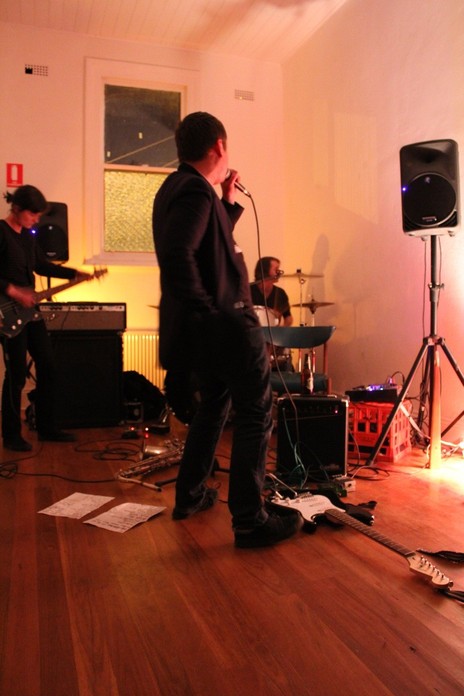
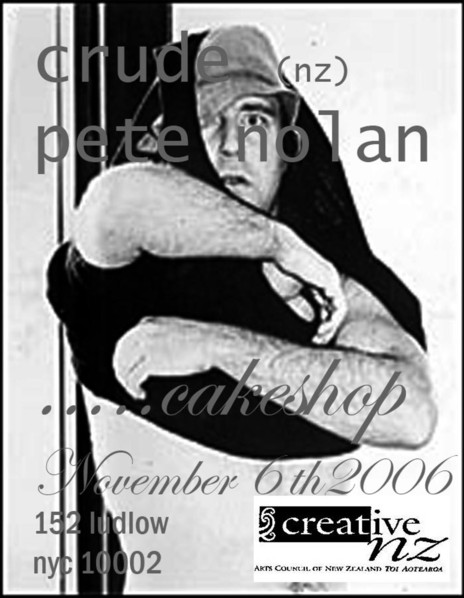
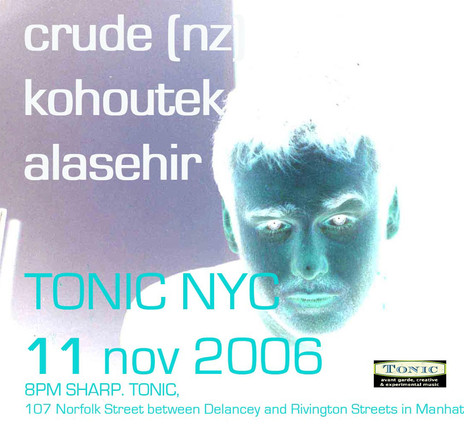
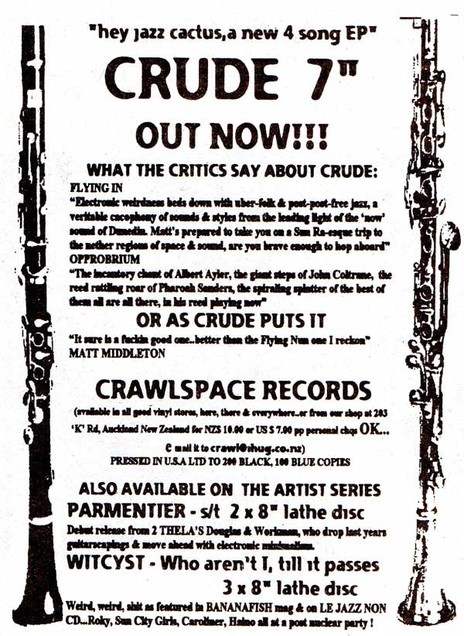
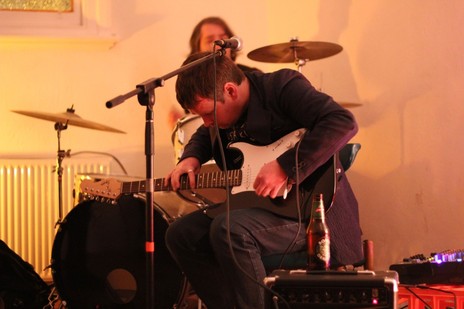
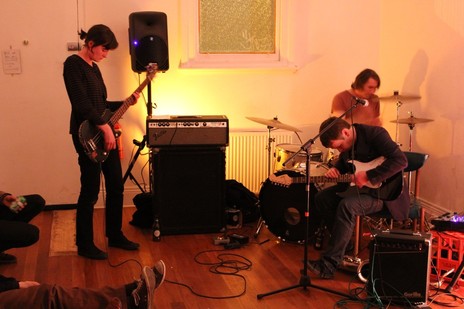
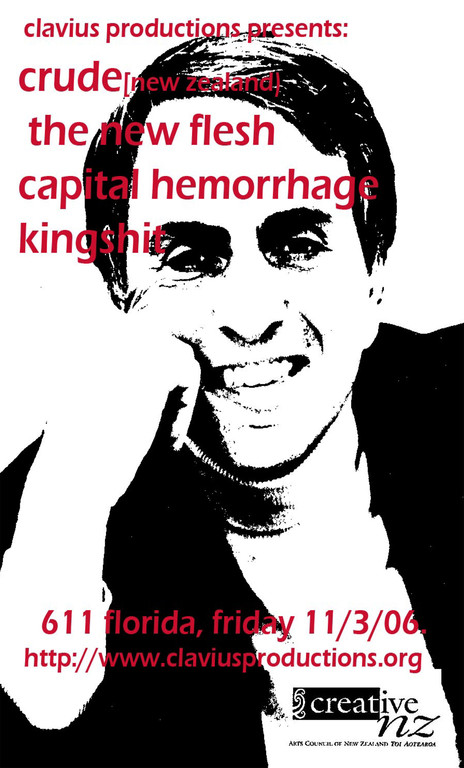
Matt Middleton - clarinet, drums, guitar, vocals, shawm, synthesiser
Visit our sister site
NZ On ScreenMade with funding from
NZ On Air





